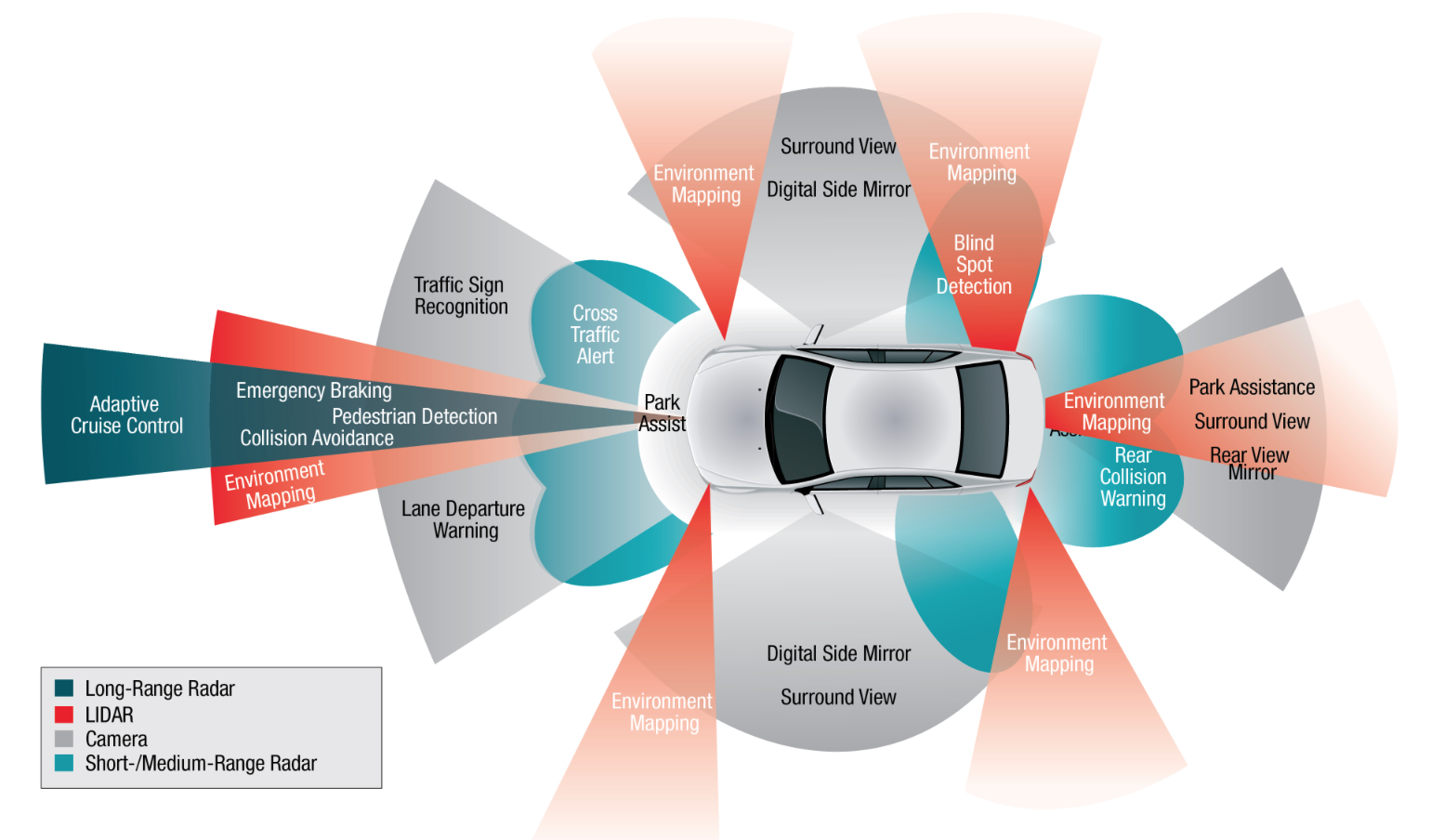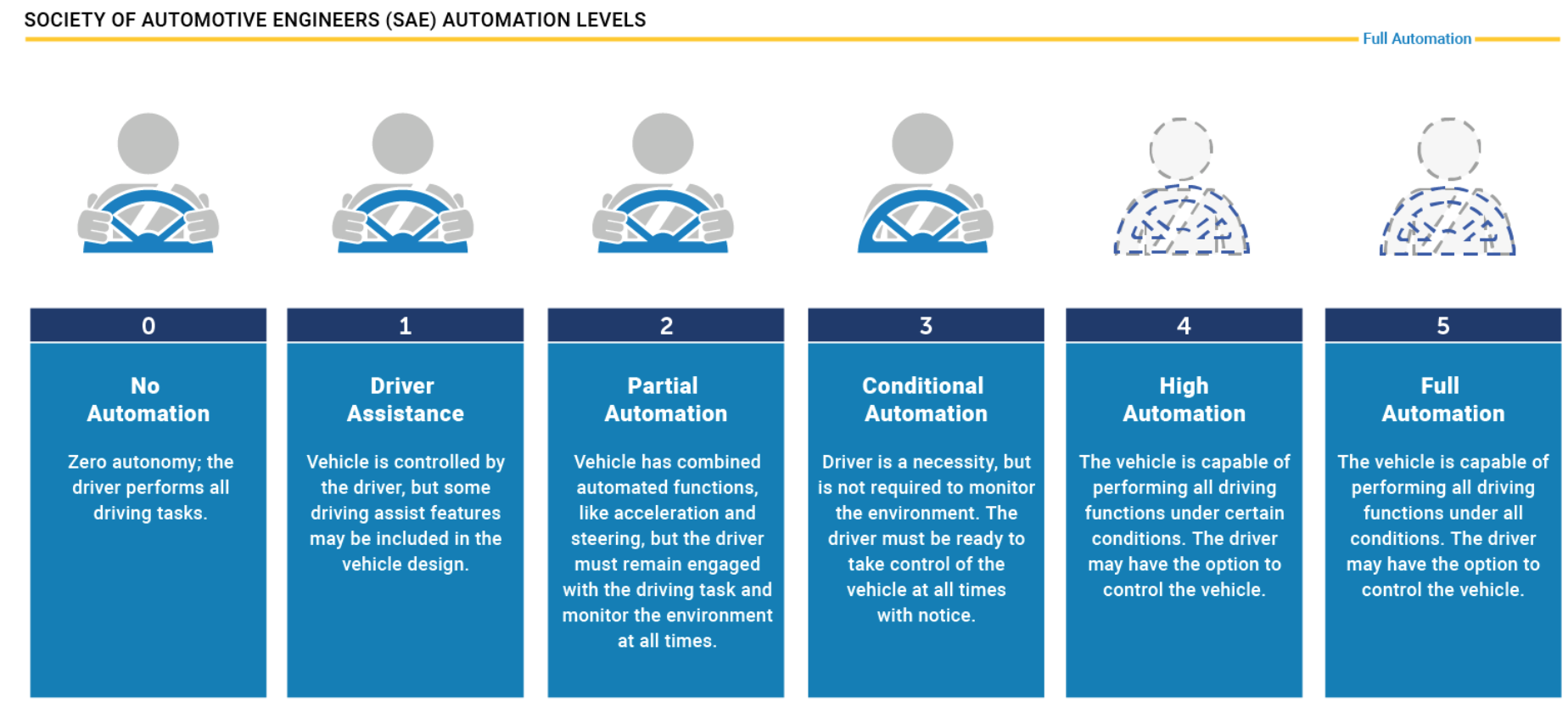Self-driving cars offer a safe, efficient and cost-effective solution that will dramatically redefine the future of human mobility.

(Courtesy of SAE International)
Self-driving cars are advanced automobiles that can travel from one point to another without human interaction. Whether these cars, where no driver ever intervenes, are fully adopted is still an open question. But, in order to reach this autonomy level revolutionary technology is required, technology that is capable of sensing the environment better than humans can. It is in this way that autonomous cars can navigate without human intervention. Self-driving vehicles are equipped with many advanced sensors; these include radar, LIDAR (Light Detection and Ranging), video cameras, and GPS (Global Positioning System).
The measurements from these sensors are interpreted by advanced computer-vision and artificial intelligence algorithms. The result is an understanding of the vehicle’s environment and a vehicle that can make smarter decisions. It is in this way that self-driving cars can identify appropriate navigation paths and avoid obstacles, steer, accelerate and brake safely, similar to how humans drive.
What’s in it for Us?
Safety alone is enough to interest most people in adopting self-driving vehicles. The benefits don’t stop there:
1) Fewer traffic accidents and congestion—Self-driving cars can cause fewer traffic accidents compared to human drivers, since they are equipped with advanced sensors and technologies that can outperform humans in every aspect. For example, self-driving cars are programmed to obey traffic laws such as speed limits and stop signs, and therefore eliminate human error.
2) Increased productivity—Because driver intervention is significantly reduced, most of the commute time can be utilized for working, reading or even sleep.
3) Enhanced mobility—Self-driving cars can drop off the driver right at the destination, without the hassle of competing for a nearby parking spot, because the car can drive and park itself at the best available location and be called to come back and pick up the driver when needed.
4) Improved fuel efficiency—Self-driving cars can optimize fuel economy and help reduce harmful emissions by optimizing the acceleration, speed and path profile in real-time.
Machine Learning is How We’ll get There
Machine Learning is the key enabling technology for self-driving cars. Behind the sensors and actuators are trained algorithms e.g. regression, pattern recognition, clustering and decision matrix. These algorithms perform tasks such as lane finding, road curvature estimation, obstacle identification and avoidance, traffic sign and traffic light detection and classification. These “skills” allow the car to understand the environment and perform needed actions for self-driving.

(courtesy of SAE International)
To achieve the high-level of reliability and performance for the safety critical system, the Machine Learning models utilized in self-driving cars need to be trained on sufficient datasets that represent the driving environment, including traffic and weather conditions. It is not unusual to see Petabytes of training data, collected from road tests utilized to develop the model. In the case where supervised learning techniques are used, the data also needs to be annotated by humans. For example, engineers have to manually label every pedestrian, car, lane and other details in the camera acquired images to teach the model to recognize.
Viviota’s Time-to-Insight (TTI) software suite provides the best Big Data management solution for Machine Learning. With TTI, engineers are quickly guided through the raw test data importing process by the DataPrep module into an organized and indexed data store. For example, DataPrep helps the engineer to unify the data format, identify the defective raw data by performing user defined automated validation process, and add Metadata to conveniently label the key objects in the test data. The DataLook module is a powerful search engine, which allows the engineers to locate, filter and group the data into a specific training set for teaching the Machine Learning model.
TTI also provides connectors to allow the event- or time-triggered execution of third-party code such Python or Matlab. In general, the TTI software suite shortens the time-consuming tasks in test data management that once took days to now happen in seconds. Viviota TTI provides a structured and collaborative data management solution to accelerate processes, eliminate non-productive data management tasks and ultimately improve the innovation process—Engineers and data scientists con focus on building better Machine Learning models, instead of managing troves of sensor data.
-End-
For more on Autonomous Vehicles - References:
Why Autonomous Vehicles will be Driven by Data Scientists
https://www.linkedin.com/pulse/why-autonomous-vehicles-driven-data-scientists-damien-deighan/
Machine Learning Algorithm in Autonomous Cars
https://visteon.bg/2017/03/02/machine-learning-algorithms-autonomous-cars/
How Machine Learning Will Drive Autonomous Vehicles
https://medium.com/toyota-ai-ventures/self-supervised-learning-a-key-to-unlocking-self-driving-cars-408b7a6fd3bd
Training AI for Self-Driving Vehicles: The Challenge of Scale
https://devblogs.nvidia.com/training-self-driving-vehicles-challenge-scale/
